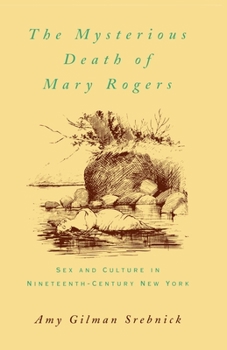The Mysterious Death of Mary Rogers: Sex and Culture in Nineteenth-Century New York
Select Format
Select Condition 
Book Overview
In the summer of 1841, Mary Rogers disappeared without a trace from her New York City boarding house. Three days later, her body, badly bruised and waterlogged, was found floating in the shallow waters of the Hudson River just a few feet from the Jersey shore. Her story, parlayed into a long celebrated unsolved mystery, became grist for penny presses, social reformers, and politicians alike, and an impetus for popular literature, including Edgar Allan...
Format:Paperback
Language:English
ISBN:0195113926
ISBN13:9780195113921
Release Date:August 1997
Publisher:Oxford University Press, USA
Length:240 Pages
Weight:0.50 lbs.
Dimensions:0.7" x 5.3" x 8.0"
Related Subjects
19th Century Accounting Accounting & Finance Anthropology Biographical Biographies Biographies & History Biography & History Business Business & Finance Cultural Gender Studies History Mid Atlantic Modern (16th-21st Centuries) Murder & Mayhem Politics & Social Sciences Professionals & Academics Regional U.S. Social Science Social Sciences State & Local True Accounts True Crime Women's StudiesCustomer Reviews
2 ratings
Sex and Death in Early Victorian New York
Published by Thriftbooks.com User , 23 years ago
Amy Srebnick has written a marvelously entertaining book of early Victorian New York, that along with the Murder of Helen Jewett by Patricia Cohen, takes the reader into a fascinating period of New York history. As an alien in this city, it is wonderful to see how the idea of New York grew out of this period. This short book manages to touch on many, interrelated topics showing how the death of Mary Rogers was used and manipulated by many people for their own political or social purposes, while her life before her death remained a mystery. People interested in the early history of the growth of abortion legislation would also be fascinated in the ways in which this touchs Mary Roger's own death. It is a fascinating book that has already led me to others covering this period.
Sex and the Single Girl, ca. 1840
Published by Thriftbooks.com User , 26 years ago
On August 2, 1841, the New York Herald told of the badly mutilated corpse of a 3young and beautiful girl2 found floating in the Hudson River. Though the random death of an anonymous individual would obviously command more attention in the press in 1841 than 1995, the death of Mary Rogers, would not, for its relative ordinariness, seem capable of provoking the intense and wide range of reaction that it did. The Mysterous Death of Mary Rogers demonstrates the way average people make history by arguing that the case sparked legislation, introduced newly acceptable subjects into the media, and inspired the birth of the crime novel. Through careful examination of the public records and contemporary fiction and non-fiction, Amy Gilman Srebnick, a professor at Montclair State University, explores the identity of Mary Rogers, the twenty-year-old descendent of prominent New England settlers living in Manhattan without a husband or father, as a panoramic window into the origins of American urban culture. She also scrutinizes the new publicization of sex, the fear of random violence in the city and the increasing economic and sexual independence of women that intersected in Rogers1 murder and subsequent resurrection through the public discourse. Contemporaries speculating at whose hands Rogers died revealed their own particular paranoia through their various theories: if you thought it was an urban gang, you were probably in fear of the city, a new cultural and physical construct at this time. If you thought it was a single individual who killed Mary, specific fear of certain New Yorkers had invaded your psyche. If you thought Rogers1 death was the result of a botched abortion, you were probably more concerned with the newly unrestrained openness surrounding, and commercialization of, sexuality, and its ramifications for the single woman. You would also probably be right. The cause of Rogers1 death remains a mystery, and though Gilman Srebnick sides with the abortion theory, she is wise not to assert with certainty one scenario over another. Though she reiterates every known detail of the murder, she uses the research not to speculate but instead to focus on what the facts tell her about Rogers1 class, habits, consorts, family history and place in New York society. Following her death, 3Mary was constructed in everybody1s image but her own,2 writes Gilman Srebnick. The numerous newspaper accounts of her death told more about their editors1 predilections than Mary1s true persona. As a member of the new female working class untethered by patriarchy or child-rearing, she represented a threat to established social order; as a young, attractive and available female, she was simultaneously alluring and threatening, and in this way 3serv(ed) as an extended metaphor for the city2 she lived in; as a possibly pregnant but unmarried woman, she was linked through residual Victorianism to a lower class standing; as the victim of a murderer or an incompetant





